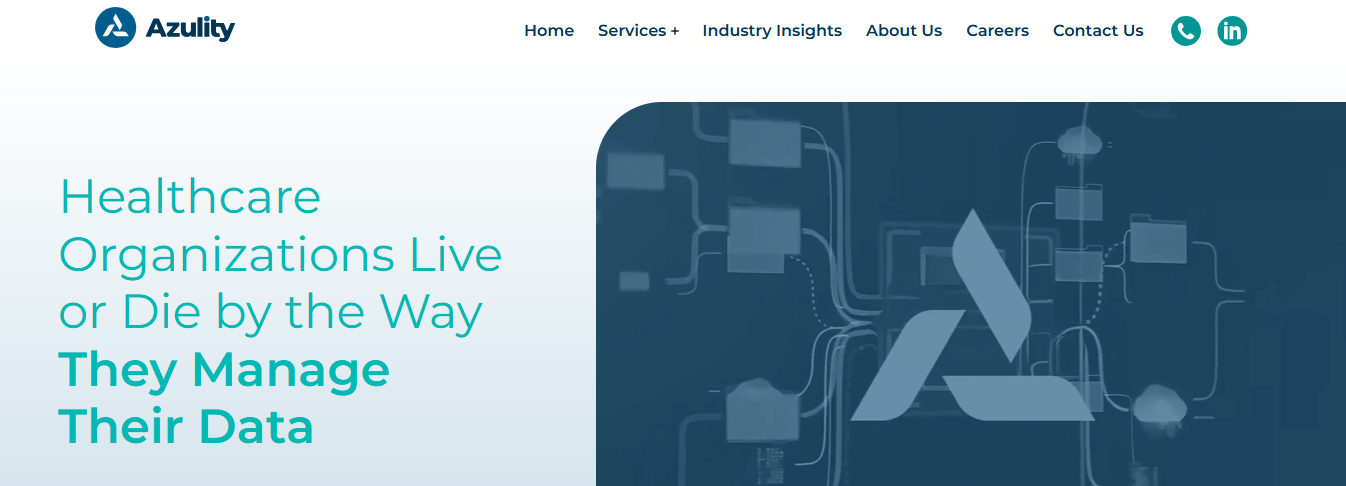With the healthcare industry facing a significant clinician shortage, the pressure on healthcare organizations to onboard new staff quickly is more important than ever. Getting new hires up to speed can be daunting. The healthcare credentialing workflow is essential to this process, especially when new hires are not fully qualified to practice independently.
For example, new nurse practitioners often require a few months of supervised practice before obtaining full licensure. During this time, it is crucial to follow a structured approach to onboarding and credentialing to ensure quality of care and compliance with industry standards.
This guide will provide a nurse practitioner credentialing checklist to help healthcare organizations streamline their healthcare credentialing workflow and allow them to onboard new staff quickly and efficiently.
One way to ease the burden of nurse practitioner credentialing is to partner with a qualified credentialing service. Azulity’s provider credentialing services can help healthcare organizations streamline their processes and reduce the risks associated with credentialing.
Importance of Credentialing for Nurse Practitioner


Nurse credentialing refers to verifying and validating a nurse’s qualifications, skills, and knowledge to practice within a specific scope of practice or specialty. It is a means of assessing and ensuring that nurses meet the established standards of competency, ethics, and professionalism.
Nurse credentialing serves multiple purposes, including protecting the public, promoting quality care, and recognizing individual achievements in nursing. It is an important aspect of the delivery of proper healthcare. Several reasons satisfy the question of why nurse credentialing is essential. But first, let us start by understanding the importance of nurse credentialing before jumping into reasons.
Importance of Nurse Credentialing
Nurse credentialing plays a pivotal role in maintaining and elevating the standards of nursing practice. It helps to establish public trust in the nursing profession by ensuring that only qualified individuals care for patients.
Credentialing also enhances patient safety by reducing the risk of incompetent or unqualified nurses delivering healthcare services. By requiring ongoing education and professional development, credentialing fosters continuous learning and keeps nurses updated with the latest evidence-based practices.
Moreover, credentialing encourages nurses to specialize in specific practice areas, such as pediatrics, critical care, or gerontology. This specialization allows nurses to develop advanced knowledge and skills, improving patient outcomes and increasing job satisfaction. Additionally, credentialing enables nurses to expand their career opportunities, gain professional recognition, and pursue leadership roles within healthcare organizations.
Credentialing for Nurses Helps to Advance Their Careers
Nurse credentialing is essential to giving nurses a boost in their careers and helping them move up the career ladder. With new education and new responsibilities, credentialing offers nurses the opportunity to explore their careers and grow professionally. Supervisory nursing is one example of nurse credentialing.
Once a nurse gets credentialed, it helps demonstrate their responsibility towards healthcare and accountability, which is a tool for achieving promotions in their career way soon when deserved.
Reduces Administrative Burden
The daily routine of a healthcare setup involves a range of administrative tasks, including paperwork, patient follow-up, insurance applications, employee licensure, etc.
The time spent fluffing these responsibilities and verifying the documents can be improved by the hospitals hiring credentialed employees.
Highlights the Dedication to the Career
When a nurse goes through a credentialing process, this shows their dedication to their field and validates that they take steps to improve and achieve higher in their field.
Credentialed nurses give a sense of trust that they have the necessary skills and the required knowledge about the type of care they provide. This ultimately reduces the risk of care, which enhances patient experience.
Types of Nurse Credentials


Various nurse credentials exist. Each reflects different levels of education, experience, and specialization. Here’s a look at the most common types of nurse credentials:
1. Registered Nurse (RN)
This is the entry-level credential obtained after completing a nursing program and passing the national licensing examination. RNs can practice in various settings and may pursue advanced practice roles.
2. Advanced Practice Registered Nurse (APRN)
APRN credentials are obtained by nurses who complete graduate-level education and possess specialized knowledge and skills in areas such as nurse practitioner, clinical nurse specialist, certified nurse-midwife, and certified registered nurse anesthetist. APRNs have expanded scopes of practice and may prescribe medications and diagnose illnesses.
3. Specialty Certifications
Specialty certifications are voluntary credentials demonstrating expertise in specific nursing practice areas. Examples include critical care nursing, oncology nursing, and pediatric nursing. These certifications are typically obtained through additional education, experience, and passing a certification exam.
4. Executive Nurse Certifications
Nurse executives who hold leadership positions within healthcare organizations can obtain certifications such as the Nurse Executive-Board Certified (NE-BC) or Nurse Executive-Advanced (NEA-BC). These credentials validate their knowledge and skills in healthcare management and leadership.
5. Continuing Education Units (CEUs)
CEUs allow nurses to maintain and renew their credentials by participating in ongoing educational activities. These activities include workshops, conferences, online courses, and professional development programs.
Azulity specializes in healthcare master data management and provider credentialing services, bringing proven expertise in implementing healthcare data solutions and credentialing across the US. Our comprehensive platform ensures consistent patient, provider, location, and claims data synchronization across all systems and departments.
Key features include healthcare MDM, provider MDM, reference data management, credentialing, and provider enrollment. We serve healthcare technology leaders – from CIOs and CDOs to VPs of data platforms and credentialing – helping them eliminate the costly problems of fragmented data systems. Book a call to learn more about our healthcare master data management services today!
Related Reading
The Ultimate Nurse Practitioner Credentialing Checklist


Start Strong: Finish Your Nurse Practitioner Program
Completing an accredited nurse practitioner program marks the first step toward becoming a certified nurse practitioner. It includes earning a Master of Science in Nursing or a Doctor of Nursing Practice degree. This rigorous education prepares graduates to provide high-quality, independent patient care.
Go for National Board Certification
After graduating from an NP program, you must obtain national board certification. This involves passing an exam administered by a certifying body, such as the American Association of Nurse Practitioners or the American Nurses Credentialing Center. Achieving national certification confirms that you possess the clinical knowledge and skills to practice safely.
Secure State Licensure
Before you begin practicing as a nurse practitioner, you must obtain state licensure in the state where you plan to work. Each state has different requirements, so it’s wise to consult the Board of Nursing for specific information. For example, California requires NPs who graduated from out-of-state programs to obtain national certification before applying for a California NP certificate and furnishing number.
Verify Your Educational Credentials
Your educational background must be verified before you can practice as a nurse practitioner. This process typically involves confirming that you meet the academic standards for practice, including verifying transcripts and degrees.
Confirm Your Active RN License
Before you can practice as a nurse practitioner, you need to ensure that you have an active Registered Nurse license. This license is a prerequisite for NP practice.
Prepare a Professional Resume or Curriculum Vitae (CV)
In your application for nurse practitioner positions, you must typically provide a professional resume or CV. This document should outline your educational background, clinical experiences, certifications, and professional affiliations.
Obtain Malpractice Insurance
Before you begin practicing, you should secure malpractice insurance coverage. This can be obtained individually or through your employer. Malpractice insurance protects nurse practitioners against potential legal claims.
Gather Letters of Recommendation
As you apply for positions, you will want to collect professional references or letters of recommendation that attest to your clinical competence and character.
Complete Continuing Education Requirements
Fulfilling any state-mandated continuing education requirements is necessary to maintain and renew your NP license and certifications.
Apply for a National Provider Identifier (NPI) Number
An NPI number is essential for billing and insurance purposes. You can apply for an NPI through the National Plan and Provider Enumeration System.
Enroll in Medicare and Medicaid
To treat Medicare and Medicaid patients, you must complete the necessary enrollment processes to become an approved provider.
Credentialing with Healthcare Facilities
Before practicing at a hospital or clinic, you must submit applications to these facilities to gain privileges and be included in their provider networks.
Related Reading
- Behavioral Health Credentialing Checklist
- Dentist Credentialing Checklist
- How to Do Credentialing in Healthcare
- Physician Credentialing Services Cost
6 Tips for Efficient Nurse Practitioner Credentialing


1. Leverage Azulity for Smooth Credentialing Workflows


Azulity is a leader in healthcare master data management and provider credentialing services. Our solutions help healthcare organizations eliminate the costly problems of fragmented data systems so you can focus on what matters. Our comprehensive platform ensures consistent patient, provider, location, and claims data synchronization across all systems and departments.
Key features include healthcare master data management, provider master data management, reference data management, credentialing, and provider enrollment. We serve healthcare technology leaders, from CIOs and CDOs to VPs of data platforms and credentialing. Book a call to learn more about our healthcare master data management services today!
2. Understand Why Credentialing Matters
Credentialing verifies your qualifications as a nurse practitioner. But it does more than simply check the boxes. Proper credentialing boosts patient trust and reduces the odds of hospital readmission.
3. Familiarize Yourself with the Credentialing Process
Credentialing follows a structured approach to verifying and evaluating your professional qualifications. This includes assessing your education, training, and experience.
4. Keep Your Documents Organized and Up to Date
Credentialing requires extensive documentation. These materials include your licenses, certifications, and educational records. Ensure all these documents are current and readily accessible.
5. Commit to Ongoing Education
Continuous professional development is key to staying current with the latest trends and best practices in healthcare. Engaging in ongoing education will ease credentialing and enhance your career as a nurse practitioner.
6. Consult with Credentialing Experts
The credentialing process can be lengthy and complicated. Consider partnering with credentialing services to streamline the process and ensure compliance with all requirements.
Book a Call to Learn More About Our Provider Credentialing Services
What is a Nurse Practitioner Credentialing Checklist?
A Nurse Practitioner Credentialing Checklist is a streamlined tool that helps ensure that NPs have completed all the requirements to practice. The checklist guides credentialing organizations to verify that a nurse practitioner meets quality care and patient safety standards. It includes details on the information and documentation needed to complete the credentialing process and a breakdown of the steps involved.
Why is the Nurse Practitioner Credentialing Checklist Important?
Like any healthcare provider, nurse practitioners (NPs) must complete a thorough credentialing process before they can practice independently or as part of a team. A nurse practitioner credentialing checklist helps to ensure that NPs can begin seeing patients as quickly as possible. NPs with the proper credentials and experience can help ease workforce shortages, especially in underserved areas and during times of crisis. The quicker they can get to work, the better.
